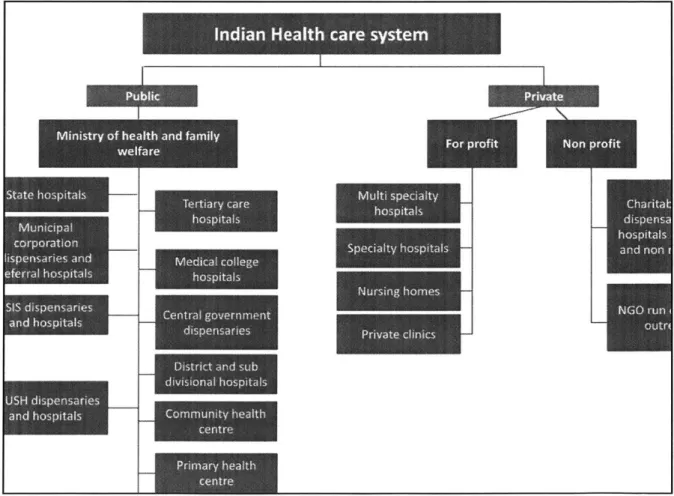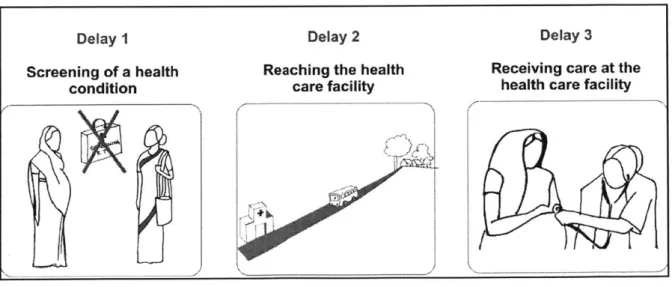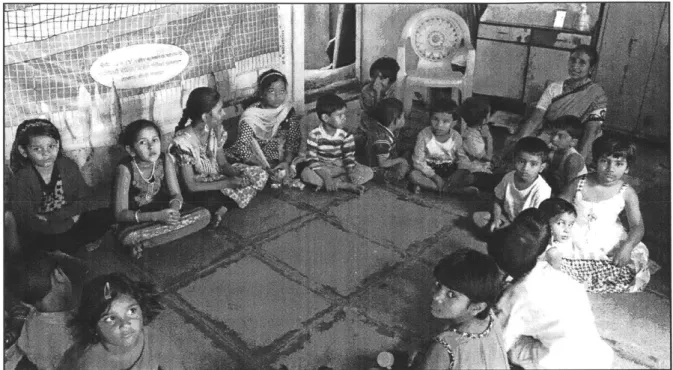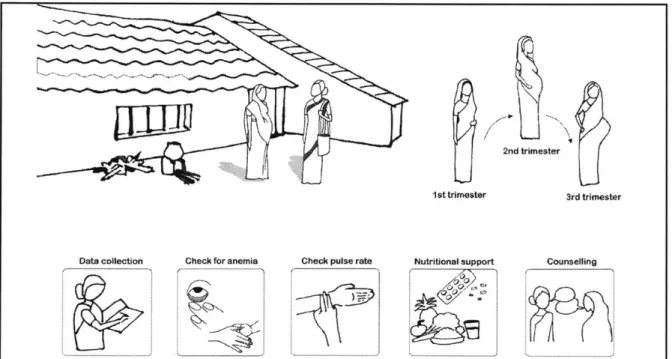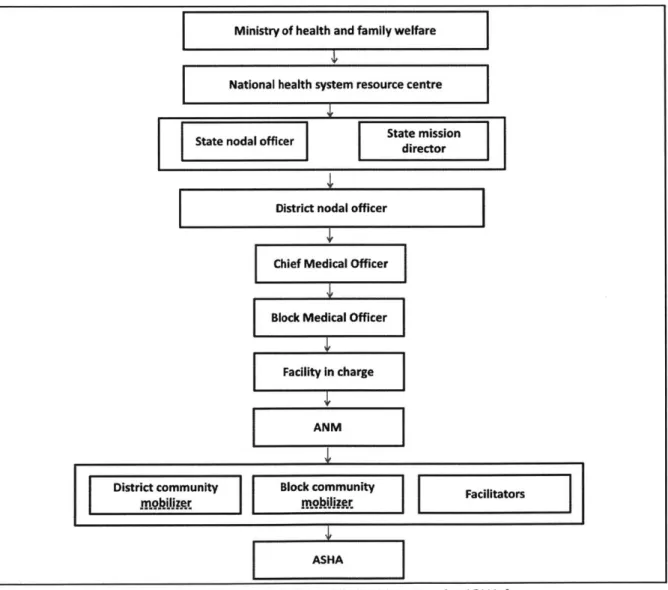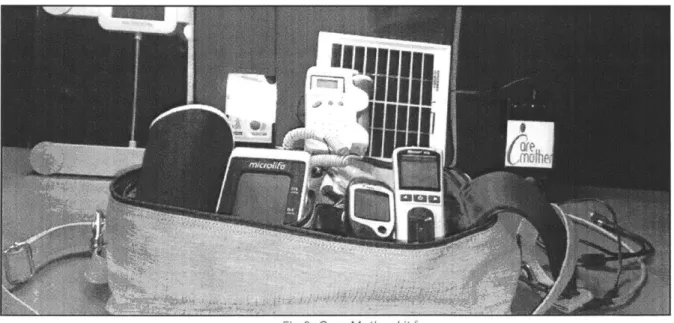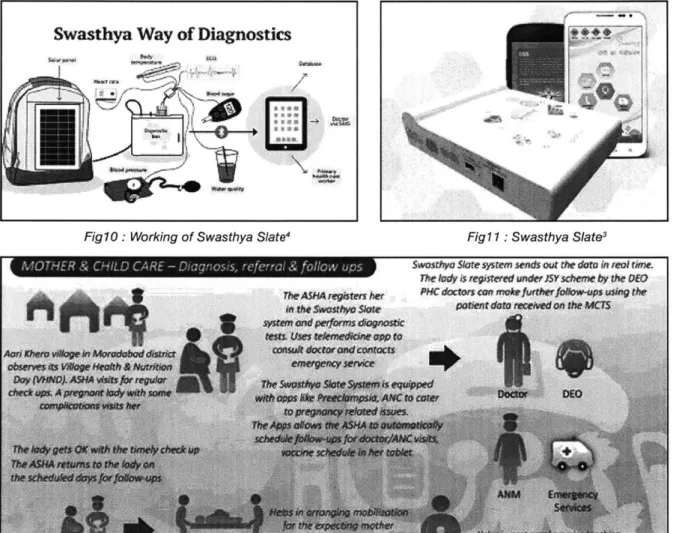Design of Mobile Health Tools for Assessment
of Health and Nutritional Status in Children
by
Honey Bajaj
B.A. in English Literature Delhi University (2007)
RD. In Product and User Interface Design Srishti School of Art, Design and Technology (2010)
'1dt1TS5STITUTE
Qr TEPIHN"OGY
fJUN
2?7?201-LIBRARIES
ARCHIVES
Submitted to the Integrated Design and Management Program In Partial Fulfillment of the Requirements for the Degree of
Master of Science in Engineering and Management
at theMassachusetts Institute of Technology June 2017
2017 Massachusetts Institute of Technology All rights reserved
Signature redacted
S ig natu re o f A utho r... . . .. . ... .Honey Bajaj Integrated Design & Management May 16, 2017
Signature redacted
Certified by ... ...
Dr. Richard Ribon Fletcher Research Scientist Head, Mobile Technology Group, MIT D-Lab Thesis Supervisor
A cc e p te d b y ... ...
Signature redacted
Matthew S. KressyDirector Integrated Design & Management Program AMIL
MITLibraries
77 Massachusetts Avenue
Cambridge, MA 02139 http://Iibraries.mit.edu/ask
DISCLAIMER NOTICE
Due to the condition of the original material, there are unavoidable flaws in this reproduction. We have made every effort possible to
provide you with the best copy available. Thank you.
The images contained in this document are of the best quality available.
This page is intentinally kept blank
Design of Mobile Health Tools for Assessment of
Health and Nutritional Status in Children
by Honey Bajaj
Thesis submitted to the
Integrated Design & Management Program in Partial Fulfillment of the Requirements for the Degree of
Master of Science in Engineering and Management
ABSTRACT
Introduction and Motivation:
In India, more than 700,000 accredited social health activists (ASHAs) are women selected and trained to work between members of their communities and the public health system. In spite of much advancement in screening tools and best practices in the healthcare system to date, service for members of the bottom of the pyramid remains largely unchanged.
ASHA workers need user friendly tools and job aids that would enable them to
- Conduct health-care screenings and consultations
- Educating communities on basic health-care practices
- Confidence to advise medical referrals for patients
Most of the existing solutions designed and deployed in the field ignore issues like context of rural/urban settings (language, living conditions), digital illiteracy, and portability.
Proposed Solution: Mobile Kit for Assessment of Child Health and Nutrition
In order to address the problem described above, the Mobile Technology Group, headed by Dr. Fletcher, is developing a smart phone based kit that will assist with the basic tasks that an ASHA health worker is required to perform. These measurements include:
- Baby's weight
- Baby's height
- Baby's thermal regulation (which is an indicator of health)
- Baby's cardiovascular health (heart rate, pulse oximetry)
- Middle Upper Arm Circumference (MUAC), which is an indicator of the nutritional
status
The electronics and computer software for these tools is being implemented by another graduate student, Xavier Soriano. However, I am responsible for the product design, interaction design, and evaluation of the technology.
Primary Research Objectives:
1. To help design the non-invasive mobile based tools for assessing and health and nutritional status of children under 5 years to be used by community health workers in urban poor settlements of India
2. To test, evaluate and assess the ease of use of these tools by community health workers
Thesis Supervisor:
Dr. Richard Ribon Fletcher Research Scientist
Head, Mobile Technology Group, MIT D-Lab
ACKNOWLEDGMENT
I would first like to thank my thesis advisor Dr. Rich Fletcher at Massachusetts Institute of Technology. The door to Dr. Fletcher's office was always open whenever I ran into a trouble spot or had a question about my research or writing. He consistently allowed this project to be my own work, but steered me in the right the direction with his extraordinary wealth of knowledge, guidance, encouragement and passion for building solutions that create an impact in the world.
I would like to thank the peers who were involved in this research project. Without their passionate participation and input, the project could not have been successfully conducted.
I am grateful to Steve Eppinger, Warren Seering, Andrew Macinnis, Melissa Parrillo, Lesley Perera, Robert Stoner and Georgina Campbell's guidance throughout the past two years and especially Professor Mathew S Kressy for his consistent mentorship and
love.
I would like to also thank all my friends and classmates, for being the most supportive and inspiring group of people.
Finally, I must express my very profound gratitude to Mr. Ratan Tata for his faith in me. Along with the support and encouragement from Tata trusts, MIT Tata Center for Design and Technology and MIT Legatum Institute of Entrepreneurship for providing me with unfailing support and continuous encouragement throughout my years of study and through the process of researching and writing this thesis. This accomplishment would not have been possible without them. Thank you.
This page is intentinally kept blank
CONTENTS
CHAPTER
1:
Introduction and Motivation
A. Public Health System and Challenges 9
B. Community Health Workers and ASHA program in India 15
C. Current Problems and Challenges Faced by Health Workers 16
CHAPTER 2: Proposed Solution: The Mobile ASHA Kit
A. Mobile Tools for Health Workers: A concept 19
B. Prior Work and Existing Solutions 21
C. The MIT Asha Kit 26
D. Scope of this Thesis 27
CHAPTER 3: Design of Tool for Baby Height
A. Current Tools and Challenges 29
B. MIT Baby Height Tool 31
C. Baby Height Tool Design Process 32
D. Tool Testing and Validation 35
CHAPTER 4: Design of Tool for Baby Weight
A. Current Tools and Challenges 37
B. MIT Baby Height Tool 39
C. Baby Height Tool Design Process 40
CHAPTER 5: Design of Tool for Malnutrition
A. Current Tools and Challenges 45
B. MIT MUAC Tool 47
C. Baby Height Tool Design Process 48
D. Tool Testing and Validation 49
CHAPTER 6: Monitoring and Evaluation
51 A. Theory of Change
53 B. Logic Framework
CHAPTER 7: Field Study in India
A. Asha Kit Feasibility Study with PHFI 55
B. Interview Guide for ASHAs 61
CHAPTER 8: Discussion and Conclusions
A. Lessons Learned to Date 67
B. Future Opportunities 68
Additional Resources 70
References 71
CHAPTER I:
Introduction and Motivation
A. Public Health System and Challenges
Public health system is a system that is concerned with a community's health and wellbeing. It is an entity that contributes to the delivery of essential public health services within a jurisdiction. It is concerned with the factors affecting the promotion and maintenance of people's health. Many factors outside the health system influence people's health, such as poverty, education, infrastructure, and the broader social and political environment.
The public health system generally includes:
- Patients, families and communities
- Ministry of health
- Hospitals at state and district levels
- Healthcare providers - doctors and nurses
- Medical schools and research organizations
- Health and nutrition services organizations
- Public health organizations
- Community health workers
- Pharmaceutical companies
- Pharmacies/dispensaries
- Health financing bodies
- Economic and philanthropic organizations
The functions of public health services include health awareness, community health statistics recording and interpreting, assessment of community's health risks and health status, Diagnosis and investigation of health problems, healthcare planning and budgeting, Aid community partnerships, Develop and enforce laws, policies and
plans for community wellbeing, Health service and infrastructure provision, Skill training for health care workforce, Design systems to evaluate health care services, Research and development, Financing and managing systems, Aid community partnerships, Develop and enforce laws, policies and plans for community wellbeing, Health service and infrastructure provision, Skill training for health care workforce, Design systems to evaluate health care services, Research and development, Financing and managing systems.
In most developing countries the public health care system consists of several tiers of service, ranging from the large hospital (Level 4 facility) to a simple 1 room health center (Level 1 facility). (see Fig 1)
MOO
ALMt
Large hospital (Level 4 facility)
- Good infrastructure - Advanced health services - Better resources
- Accessible
Rural health center (Level 1 facility)
Poor infrastructure
Basic health services - Poor resources - Poor accessibility
Fig 1: Tiers of hospital facilities in India I
10
as
U..m
noi',
V'
DN
.
.
.
.
.
.
.
.
.
.
.
.
.
.
.
.
.
.
.
'-. Of N N1. Indian Public Health System and Challenges
India has a population of 1.2 billion people, whereof three quarters live in rural areas'.
There are over 35,000 public hospitals across 29 states in India2. In 2005 the Government
launched the National Rural Health Mission (NRHM), a health program in mission mode to improve the health system and the health status of the people, especially for those who live in the rural areas, and provide universal access to equitable, affordable, and quality healthcare. A component of NRHM at state level measures clinical output and performance indicators, and reports it regularly to the national level. This data helps the state and national health ministries to plan further programs based on the impact
created.'
2.Structure and Organization
Under the Indian Constitution, each state is responsible for the functioning of its healthcare delivery system in which both public and private (for profit as well as nonprofit) players operate. The Central Government takes care of policy-making, planning, guiding, assisting, evaluating and coordinating the work of various provincial health authorities and providing funding to implement national programs.
The organization at the national level consists of the Union Ministry of Health and Family Welfare (MoHFW). In each State, the organization is under the State Department of Health and Family Welfare that is headed by a State Minister and with a Secretariat. The Indian public healthcare system consists of both Allopathy and AYUSH (Ayurveda, Yoga, Unani, Siddha and Homeopathy). In every state, each regional set-up covers 3-5 districts and operates under the
State Directorate of Health Services. The district level structure of health services is a link between the State and regional structure and the peripheral level structures such as Primary Healthcare (PHC) and Sub-Centre.'
3.Challenges in the Indian Public Healthcare System
1. Poor infrastructure and underutilization of existing resources2. Shortage of specialists and doctors - There is only one doctor per 1,700 citizens in India.
3. Overcrowded hospitals - Poor patient management processes 4. Low skilled auxiliary staff and nurses
5. Poor access to hospitals: 70% healthcare infrastructure in is the urban areas 6. Poor awareness among people
7. Lack of preventative healthcare and early diagnosis
Fig 2: India health care system I
12 el I,- K 4--IBM La w-l'"'', "are syse -
---4. Three main delays in the Public Healthcare System
The three major delays that constitutes one of the major challenges in the public healthcare system are:
1. Delay in the deciding to seek appropriate medical help: Poor awareness and understanding of complications and risk factors, and financial implications are some of the key reasons for delay in seeking health care at the appropriate time. A delay in the recognition of a potentially severe condition will decrease the likelihood that appropriate care will be provided in a timely and effective fashion.
2. Delay in reaching the health care facility: Parts of India have a topology that makes access o healthcare facility difficult and travel time-consuming. This is worsened by poor roads and lack of proper infrastructure like public transport, also high cost of transportation. Effective care improves survival by decreasing the time to treatment.
3. Delay in receiving adequate healthcare: Even after a patient reaches a healthcare facility, due to poor facilities, inadequately trained medical staff and lack of medical supplies, coupled with a poor referral system causes delays in receiving good healthcare at the hospitals. Delay at this stage worsens patient outcome and their perception of the quality of health services and thus their willingness to avail medical help in the future.
Delay I Delay 2 Delay 3
Screening of a health Reaching the health Receiving care at the condition care facility health care facility
Fig 3: Three delays in the healthcare delivery system
Fig 4: Community health worker conducting preventive health camp for children below age 5 at a Balwadi
Data collection
.... .... ... .... ... ... .... ... .... ... .... ...
Weight Blood pressure
...
Fetal heart rate Blood and urine tests
Fig 5: Preventive health checkups for pregnant women at the village health camp
14
Vt LLk (A6
4A
B. Community Health Workers and ASHA program in India
In order to address these challenges in the public health acre system, the many developing countries, including India, have created a system of community health workers
(CHW). The role of CHWs is to assist doctors and nurses in activities such as immunization
and health promotion, and also act as social and cultural intermediaries strengthening the interface between the existing health system and the community. They facilitate community participation to address the socio-cultural barriers that lead to poor health.
Importance of preventive health care:
Preventive health care is a measure to identify and minimize the risk of disease, improve the course of an existing disease and screening for early detection of disease. Preventive health care is very important during pregnancy because if certain conditions are diagnosed during early stages of pregnancy, unnecessary complications can be avoided during and post child birth. Hence, preventive health check-ups help in bringing down morbidity and mortality rates, and the cost of medical emergencies.
ASHA worker
In India specifically, the government has created a health worker program called the ASHA program, which stands for Accredited Social Health Activist. ASHA program was introduced by the National Rural Health Mission (NRHM) in 2005. They are female cadres of India's community health worker programme.
The ASHA (Accredited Social Health Activist) programme is considered as being vital in achieving the goal of increasing community engagement with the health system and is one of the key components of the National Rural Health Mission (NRHM) that was launched in 2005 by Government of India. To complement the work of ANM, ASHA is selected from the community, a resident in the community, who is trained and deployed 15
and supported to function in her own community to improve the health status of her area through securing people's access to health care services. She is the first port of call for any health related demands of deprived sections of the population, especially women and children, who find it difficult to access health services. She is a health activist in the community who creates awareness on health and its social determinants and mobilizes the community towards local health planning and increased utilization and accountability of the existing health services. She is a promoter of good health practices. She also provides a minimum package of curative care as appropriate and feasible for that level and makes timely referrals. She is a link worker for promoting universal immunization, referral for RCH, construction of household toilets, and other healthcare delivery programs Thus, without any formal medical training and limited academic education (most ASHAs have a 10th grade education), the ASHAs are given incredible responsibilities to look after the broad diverse array of health needs for the entire community. Unlike other health care staff ASHAs don't have any office or clinic, but simply go door-to-door, providing education, counseling, health screening, and referrals for both the young and old.
The National Health Mission in India offers several platforms for home-based newborn care (HBNC), and the presence of a trained ASHA (Accredited Social Health Activist) in the community is one of these primary platforms - particularly for families who don't live close to a large community hospital. ASHAs are considered as the main cadre of front-line workers to provide HBNC.
C. Current Problems and Challenges Faced by Health Workers
"
Lack of continuous and monthly income: ASHAs work on contract and get a variable pay based on their performance. This does not motivate them to continue for a long time and hence the resources spend on training them remains underutilized." Poor education and skills: ASHAs are usually qualified until school (10th grade).
If there is no suitable literate candidate, a semi-literate woman with a formal education lower than eighth standard, may be selected.
* Lack of tools and training to support their work: Since ASHAs are contract workers, many hospitals do not trust them with screening kits and tools, and mentoring support that help them with their work.
* Heavy work load: One ASHA is assigned for 1000 people and she takes care of multitude of health problems. Hence, her work load is high, affecting her efficiency. * Safety issues: Being women, ASHAs are limited in their movement and reach
due to safety concerns. Especially during night time, they need a male member to accompany them and have to negotiate with family for performing her duty at night.
* Socio-cultural issues and taboos: For many family health issues, the ASHA has to talk to both the male and female members of the families. Being a woman, she faces a lot of resistance among male members and this greatly affects her performance.
2nd trimester
1st trimester 3rd trimester
Check pulse rate Nutritional support
Check for anemia
Fig 6: Routine activities during ASHA visits
17
Counselling Data collection
Hierarchy in Public Health System for ASHAs
Central Government nominates a State Nodal Officer who ensures that resources are available to provide training support for ASHAs at district and block level. ASHAs are trained for a year for different health conditions. At the district level, there is a District Nodal officer who heads and supports the district community mobilizer, block community mobilizer and facilitators. The district medical officer at the PHCs and CHCs heads the ANMs and other health care workers, who in turn monitor and evaluate an ASHAs work.
Ministry of health and family welfare
National health system resource centre
State nodal officer State mission
director
District nodal officer
Chief Medical Officer
Block Medical Officer
Facility In charge
ANM
District community Block community Facilitators
ASHA
Fig 7: Hierarchy in the public health system for ASHAs
CHAPTER 2:
Proposed Solution: The Mobile ASHA Kit
A. Mobile Tools for Health Workers: A concept
In order to improve the current productivity and impact of ASHA health workers, our
group at MIT D-Lab, headed by Dr. Rich Fletcher, has developed the concept of
mobile-phone based tools to support health workers. Given the rapid increase in mobile mobile-phone adoption by even poor communities around the world, there has been great interest from many organizations to make use of this technology for public health applications. Unfortunately, however, the use of phones thus far has been primarily limited to its use as a data entry device, as a replacement for paper forms.
The concept developed by our group is to use mobile phones for more than just data entry, and use them as sensors and computers to automatically capture vital signs of the patient and automate much of the tasks that are done by the health workers.
Fig 8: App measuring baby malnutrition level using the ASHA kit from Mobile technology lab
B. Prior Work and Existing Solutions
A few groups around the world have begun to develop some next-generation tools to support community health workers. But many of these tools are too large and too cumbersome for practical use.
Care Mother kit
- Developed by Shantanu Pathak, Adithya Kulkarni and Anurag Meena from Care, Mumbai in India
Care Mother is a diagnostic kit + mobile application which can conduct 8 tests for pregnant women inorder to enable early identification of high risk pregnancies. This can avoid conditions like gestational diabetes, hyper tension, anemia, improper nutritional growth and fetal distress. The ASHA worker carries this kit along with her visits during her hand conducts these tests at the mother's home. The solution also enables electronic health recording.
At door care in rural region saves tests and traveling expenses for pregnant women. Further it reduces operating expenses of implementing agencies by decentralizing
services through health workers and one click data management. 5
Fig 9: Care Mother kit'
The Swasthya Slate
- Developed at the Public Health Foundation of India by Dr. Karnav Kohol.
Swasthya Slate (Health Tablet) is an affordable bluetooth-enabled integrated diagnostic kit that works with an android based mobile system, to perform 33 diagnostics tests. Its purpose is to increase access to health care and health education in the country. The solution is able to record a patient's medical history, basic medical indicators, offer
on-the-spot diagnosis on the basis of the information gathered. and even has decision support tools to enable users to deliver quality recommendations for achieving better health. Policy Makers can get real time data from portals and enhance data driven policy
making. 3
Swasthya Way of Dliagnostics
I ~ _
Fig 10: Working of Swasthya Slate 4 Fig 11: Swasthya Slate3
Th dy is registeied under JSY scheme by the OEO
T heASAMt he r po do s can mAke$rther fiefowfups using the
illi q a& ;A ath Ctmel parienf daro receied on ihe MCTS
Fig 12: Swasthya Slate for mother and child care3
CommCare
- Developed by Dimagi, USA based software technology consultancy and software company
CommCare is a M-health solution to support ASHAs by facilitating better data collection, decision support, communications with clients and health centers, and access to educational training materials. In particular, Comm Care improves ASHAs' performance by tracking case management data in real time - the households they visit, the duration of these visits, the services provided during each visit, the quality of their decision-making (based on adherence to checklists and protocols), and the health outcomes of the households they serve.
The software includes registration forms, checklists, a tool for monitoring danger signs, and educational prompts with images and audio/video clips available in multiple languages. Comm Care has also been shown to increase the retention of health-related knowledge among ASHAs and to help them keep up with their scheduled visits. Ultimately Comm Care increases confidence among ASHAs and also improves engagement with clients. Comm Care Complements this community-based public health strategy by providing a mobile platform that can be used by CHWs and tailored to a diverse range of local needs and conditions.
.... ... Conu ~ nCars C m
Fig 13: Comm Care products
ChildCount+
- Developed by Millennium Villages Project, Kenya
ChildCount+ is a mHealth platform aimed at empowering community health workers to improve child survival and maternal health. ChildCount uses SMS text messages to facilitate and coordinate the activities of community health care workers (CHWs). Using any standard phone, CHWs are able to use text messages to register patients and report their health status to a central web dashboard that provides a real-time view of the health of a community. Powerful messaging features help facilitate communication between the members of the health system and an automated alert system helps reduce gaps in treatment. It aims to:
- Register every child & pregnant woman - Create a "living" registry of all children under five and pregnant women in a community. Record all births, deaths and pregnancies.
- Routine nutrition screening every 90 Days - Monitor the nutrition of every child from 6 months to 5 years every 90 days. When a child with acute malnutrition is detected the program provides support based on community based management of acute malnutrition protocols.
- Treatment support for malaria, diarrhea and pneumonia - track and treat the three
major preventable causes of death in children under 5. ChildCount+ manages clinic referrals and CHW follow-up visits.
- Complete immunization for all children - Track the immunization status and
follow-up with defaulters to ensure that every child completes their immunization schedule.
- Comprehensive antenatal and post-natal care - Ensure that every pregnant
woman attends at least 4 antenatal appointments and every child attends every childhood health appointment from 6 weeks to 18 months old.
How It Works
A community health worker ECHVV) who has been
registered with the system visits a household and
performs a nutritional
screening for all children 5
years and younger. They perform a MUAC (Mid-Upper Arm Circumferencel and check for Oedema which is swelling of the body; a sign of severe acute malnutrition
ISAM[ They fill out a
form, and send a formatted text message into the system.
4 ---- - --k-Inrr 4-CHW sends a formatted SMS D324F +M110 Y
ChdCount+ Sends an instant
response with instructions
MUAC> Child +28 Fatimata
ChildCount+ Diafo FI13M has SAM+.
sends a
rem!"nder -Please bring child in for
IME-citaw toDIATE inpatient care.
schedul. a
foow up visit
with the child
Fig 14: Child count uses MUAC to measure malnutrition for children
C. The MIT ASHA Kit
Background and rationale for developing the MIT ASHA Kit
The ASHA (Accredited Social Health Activist) program is considered as being vital in achieving the goal of increasing community engagement with the health system and is one of the key components of the National Rural Health Mission (NRHM) that was launched in 2005 by Government of India.
Home Based Newborn Care (HBNC) is a one of the key components of maternal, neonatal and child care under the National Health Mission (NHM) and the government of India. There is enough evidence that despite an increase in the institutional deliveries in India, a substantial proportion of neonatal deaths occur at home. Also the most vulnerable period of a newborns life is the period during the birth and the first week of life and three quarter of neonatal death occurs during this period. The remaining 25% of newborn deaths occur during the second to fourth week of life. Thus, HBNC is a
critical component to preventing newborn deaths. The National Health Mission in India offers several platforms for home-based newborn care (HBNC), and the presence of a trained ASHA (Accredited Social Health Activist) in the community is one of these primary platforms - particularly for families who don't live close to a large community hospital. ASHAs are considered as the main cadre of front-line workers to provide HBNC.
Childhood malnutrition on the other hand, encompasses nutritional disorders that include stunting, underweight, wasting, severe acute malnutrition (SAM), and micro-nutrient deficiency disorders. It also includes overweight and obesity, at the other end of the nutritional spectrum. An estimated 50 million children under-5 years of age were wasted and 17 million severely wasted worldwide(an approximate prevalence of 7% and 3% respectively) in 2015. Half of all acutely malnourished children lived in South Asia and one quarter in sub-Saharan Africa. A child with SAM is 9 times more likely to die than a well nourished child. SAM is one of the top 3 nutrition-related causes of death in children younger than 5 years. Moderate and severe child malnutrition account for 40% to 50% of all deaths in children younger than 5 years.
Thus providing quality HBNC and screening of nutritional status children in the community has the potential for their timely referral to health center upon detection of any morbidity or malnourished status and also timely counseling for prevention of further deterioration. The MIT ASHA Kit has the potential to enable the ASHA workers to perform quality screening of these children and provide timely referral and counseling.
Description of mobile health tools for ASHA workers
The Mobile Technology Lab directed by Dr. Rich Fletcher at D- Lab has been developing several mobile tools that can be used to empower the community health workers (ASHA or Anganwadi workers). Some of these tools can be utilized to enhance the quality of care and decision making while assessing health and nutritional status of children under 5 and providing HBNC during home visits by ASHAs.
These tools include the following:
A) Baby blanket for measuring length of newborns and infants - Using a special woven pattern for the blanket, we use augmented reality to create a calibrated scale that will automatically measure the length of a baby placed on the blanket.
B) Mobile weight measurement - Using the augmented reality technology the team is developing a mobile phone app that can automatically capture the reading from a baby weighing scale. Using the phone camera, the special software automatically recognizes the scale and captures a reading. The phone software is able to recognize a pattern on the MUAC band, and it can automatically calculate the MUAC reading and store the value on the phone.
C) Measuring Mid-Upper Arm Circumference (MUAC) - MUAC is the standard measurement and a screening tool for measuring malnutrition in children under 5 years. Using augmented reality, this can also be automated and digitized. The phone software is able to recognize a pattern on the MUAC band, and it can automatically calculate the MUAC reading and store the value on the phone.
D) Photoplethysmography (PPG) - A PPG device, similar to a standard pulse oximeter, has been developed which can be clipped onto the child's hand or foot. This device connects to the mobile phone which records and analyzes the data. By analyzing the pulse waveform, several other parameters can be extracted, including stroke volume, and pulse oximetry.
E) Thermal camera - A special small camera attaches to the phone and is able to record the temperature readings from the baby or child. From the thermal image, it is possible to automatically record the temperature from several points on the baby's face
and body. This information is used to assess the thermal regulation of the baby, and can also be used to detect inflammation or sepsis.
F) Billirubin measurement - A plastic strip containing a color scale is used to assess possible jaundice in young infants. Special software on the phone will take a photo of the bilirubin color scale and perform automatic color analysis to estimate the level of
bilirubin.
D. Scope of the thesis
ASHA kit includes many tools as described in the MIT ASHA Kit as mentioned in section C of Chapter1 but that for the thesis I have helped in development of the following tools:
- Baby blanket for measuring length of newborns and infants
- Mobile weight measurement
- Measuring Mid-Upper Arm Circumference (MUAC)
The thesis primarily has two parts: Part A: Design & Development
- Mechanical design of the tools
- Interaction design
- Graphic design
- Prototyping & Testing
- Designing the AR Target
Part B : Materials for pilot study with Public Health Foundation of India, Delhi
- Training plan for the ASHAs
- Video for the products in use
The technical part (mobile programming) is being done by Xavier Soriano, and that his thesis will include a performance evaluation of the technology.
CHAPTER 3:
Design of Tool for Baby Height
A. Conventional Tools and Challenges
Measuring baby's height is one of the useful non-invasive methods and indicators for assessing their growth and wellbeing. By comparing this measurement over a period of time, helps determine baby's growth pattern and identify deviations from the norm and conditions like abnormal growth and obesity.
The two most commonly used height measurement tools for children up-to 24 months of age are height board and measuring tape. Up-to this age, baby's height should be measured without any clothes on them. Clothes, including a nappy, can distort the measurements. This also helps the health care professional assess child's body proportions. While measuring the baby's height with the height board, two health workers are needed to obtain an accurate measurement - one to support the baby's head and one to straighten their knees and ankles. Readings are then taken by the staff to the nearest millimeter. Post 24 months of age, height of the baby can be measured with them standing against a scale. The child should stand straight against the measuring device, looking straight ahead and measured to the nearest millimeter. Measuring height of a baby is comparatively more difficult because it is difficult to make them lie down and
hold in the appropriate position.
A referral or immediate action should be made if the length is greater than the 99.6th percentile or lower than 0.4th percentile. This covers at least half of all children with growth hormone deficiency and other abnormalities.
TOOLS
TOOL IN USE
CHALLENGES
Infantometer also called
Measurement tape
0,;
Length board9
J4
30
- Not easily portable
- Difficult to measure
when the infant is moving
- Manual data
recording
- Training required to
interpret the data
- During winters
placing the baby on a cold surface - Difficult to measure precise readings - Unreliable data - Manual data recording - Training required to
interpret the data
- The edges of the
measuring tape is not user friendly for the baby
B. MIT Baby Height Tool
The tool is a special designed pattern blanket along with an app which uses machine vision to measure the height of the baby. The app consists of two parts:
- Image recognition to identify a pattern and track the pattern.
- The augmented reality software displays and overlays the measurement which
gives feedback to the user.
We are using augmented reality to create a calibrated scale that will automatically measure the length of a baby placed on the blanket.
The tool solves many challenges faced while using the conventional tools as mentioned in the section A. Most importantly it enables a community health worker to track the progress of the baby.
C. Baby Height Tool Ideation
Fig 16: Ideation and mind-map to design the AR target for measuring baby height
IIS
C7
010
40.
...
...
...
...
.
...
...
.
...
...
--
-
---
---
...
...
...
....
---
---
I
.
.
.
...
.
...
...
...
1-
--
.1
---...
...
...
.
.
.
..
...
.
...
.
.
.
...
...
...
.
....
...
...
...
.
...
.
...
..
...
...
...
.
.
.
...
.
...
-.-
.
...
.
...
.
...
.
...
...
.
...
.
...
.
...
...
...
...
.
...
.
...
.
...
.
...
...
...
....
...
...
...
...
-.-
...
...
...
.
...
.
...
...
...
mirs
33Fig 17: First iteration of the baby blanket using the augmented reality target
L
Fig 18: Testing the baby blanket and the augmented reality target
34
L
D. Tool Testing and Validation
The following tests were used for lab testing and validation:
1. Test for validating the application by holding the phone in different angles to check the reading on the app of the baby height compaired to the manual reading.
15* 0*
30* 450 600
Distance Height of Manual baby's length 60.5 cms Mean Standard
from baby the phone Reading from the app deviation
Patient id Angie (CMs) (cmns) 1 2 3 4 5 1 0 0 48.03 60.85 61.05 60.91 60.85 60.97 60.93 0.09 2 15 31 46.06 61.14 61.42 61.42 61.42 61.42 61.36 0.13 3 30 63 43.3 61.68 61.71 61.71 61.71 61.48 61.66 0.10 4 45 90 35.43 62.02 62 61.99 62.02 61.8 61.97 0.09 5 60 135 30.7 62.42 62.34 70.77 62.62 62.37 64.10 3.73
** Ughting level 550 lux constant
2. Test for validating the application in different light settings to check the reading on the app of the baby height compaired to the manual reading.
Baby Sizes Mean Standard
Light level (lux) Light level (lux) (manually deviation
light meter facing light meter measured Reading from the app
Patient Id ceiling facing baby height in cms) 1 2 3 4 5
1 25 14 35.5 36.22 38.37 38.28 38.28 38.57 37.94 0.97 2 50 38 35.5 36.74 36.34 37.14 36.57 36.68 36.69 0.29 3 100 84 35.5 37.34 37.6 37.6 37.42 36.85 37.36 0.31 4 500 360 35.5 35.71 35.68 35.51 35.71 35.65 35.65 0.08 5 25 14 51 49.25 52.25 53.42 52.51 53.19 52.12 1.68 6 50 38 51 55.42 55.71 54.97 56.28 54.08 55.29 0.83 7 100 84 51 51.42 52.57 52.28 52.28 51.17 51.94 0.61 8 500 360 51 52.97 53.42 53.42 53.22 53.42 53.29 0.20 9 25 14 60 62.28 62.85 67.74 62,85 6311 63.76 2.24 10 50 38 60 62.85 63.14 63.54 62.14 62.37 62.81 0.57 11 100 84 60 62.28 70.57 62 62 62.28 63.83 3.7 12 500 360 60 60.6 60.85 60.57 60.57 60.57 60.63 012 35
3. Test for validating the application in comparing the reading on the app of the baby heights compared to the manual readings.
35.5 36.28 36.28 36.25 36 36.31 22.29 0.13 -0.78 39 40.97 40.88 40.88 41.14 41.14 36.22 0.13 -1.97 51 54.28 54.28 54.22 54.28 54.28 41.00 0.03 -3.28 21 22.37 23.45 23.45 21.02 21.14 49.56 1.19 -1.37 49 49.42 49.71 49.62 49.42 49.65 50.74 0.14 -0.42 50.8 50.85 50.85 50.57 50.74 50.68 51.46 0.12 -0.05 52 51.42 51.42 51.41 51.42 51.65 52.91 0.10 0.58 53 53.14 52.85 52.85 5285 5285 53.36 0.13 -0.14 53.8 5342 53.39 53.42 5345 53.14 54.20 0.13 0.38 54 54 54.28 54.28 54.17 54.28 54.27 0.12 0 54.8 55.14 55.14 55.14 55 55.14 55.11 0.06 -0.34 56.5 56.85 56.85 56.85 57.14 56.85 56.91 0.13 -0.35 57 5742 57.25 57.28 5742 57.42 57.36 0.09 -0.42 58 58 58.28 58 57.99 58 58.05 0.13 0 59.2 5942 5942 59.42 59.54 59.45 59.45 0.05 -0.22 60 60.57 60.28 61.14 60.28 60.28 60.51 0.37 -.057 61 61.14 61.14 61.14 61.02 61,14 61.12 0.05 -0.14 0 .... -2 -3 -4 0 17.5 35 52.5 70 Centimeters
Fig 19: The Bland Altman plot to measure the variability in baby height
36 .2' 0 U 4.. .2' 0 0 1.. U' 0
CHAPTER 4:
Design of Tool for Baby Weight
A. Conventional Tools and Challenges
Weight is the most commonly checked growth parameter of the baby. It is also the most accurate and sensitive measurement of baby's growth. Interpretation of weight includes review of current and previous weight measurements, child's social and domestic environment and its food intake. By checking a child's weight regularly, its growth can be mapped and monitored. Thus, enabling the health care worker to see periods of no growth or weight loss and catch early signs of growth abnormalities.
Several tools are used to weight a child's weight like Salter scale, weighing scale and uniscale. The Salter scale is an analog, reliable and portable scale, which can weigh children weighing up to 25 kg. The scale has a hook which is used to hang the sling or pants in which the child is placed for weighing. The weighing scale is an analog or digital scale with provision to make the child lie down lie measuring its weight. With the uniscale, made by UNICEF, the mother can hold the child and stand on the scale. This scale can be re-set to zero when the person (mother) weighed is still standing on it. Thus, the child's weight alone appears on the scale.
TOOLS
TOOL IN USE
CHALLENGES
Salter scale'
Weighing scale
12Uniscale
13 - Needs calibration - Prone to errors - Not easily portable - Manual record keeping- Training requited to interpret data
- Needs calibration - Not easily portable - Manual record keeping - Training requited to
interpret data
- Needs calibration - Not easily portable - Manual record keeping - Training requited to
interpret data
38
B. MIT Baby weight Tool
The tool is a special designed sticker with a pattern along with an app which uses machine vision to measure the weight of the baby. The app consists of two parts:
- image recognition to identify a pattern and track the pattern.
- the augmented reality software displays and overlays the measurement which
gives feedback to the user.
We are using augmented reality to create a calibrated scale that will automatically measure the weight of a baby placed on the weighing scale.
The tool solves many challenges faced while using the conventional tools as mentioned in the section A. Most importantly it enables a community health worker to track the progress of the baby.
Fig 20: Asha worker taking the help of a mother to measure the baby weight
C. Baby Weight Tool Ideation
Fig 21: Iteration on augmented reality target for the weighing scale
d
h
,~
I
A
I..
*1
U
40Fig 22: Image showing adjustment of the baby scale before measuring the weight
Fig 23: Testing the baby weighing scale and the augmented reality target
D. Tool Testing and Validation
1. Test for validating the application in different light settings to check the reading on the app of the baby weight compaired to the manual reading.
Baby Sizes Mean Standard
Light level (lux) Light level (lux) (manually deviation light meter facing light meter measured Read ing from the app
Patient id ceiling facing baby height In cs) 1 2 3 4 5
1 25 14 35.5 36.22 38.37 38.28 38.28 38.57 37.94 0.97 2 50 38 35.5 36.74 36.34 37.14 36.57 36.68 36.69 0.29 3 100 84 35.5 37.34 37.6 37.6 37.42 38.85 37.36 0.31 4 500 360 35.5 35.71 35.68 35.51 35.71 35.65 35.65 0.08 5 25 14 51 49.25 52.25 53.42 52.51 53.19 52.12 1.s 6 50 38 51 55.42 55.71 54.97 56.28 54.08 55.29 0.83 7 100 84 51 51.42 52.57 52.28 52.28 51.17 51.94 0.61 8 500 360 51 52.97 53.42 53.42 53.22 53.42 53.29 0.20 9 25 14 60 62.28 62.85 67.74 62.85 63.11 63.76 2.24 10 50 38 60 62.85 63.14 63.54 62.14 62.37 62.81 0.57 11 100 84 60 62.28 70.57 62 62 62.28 83.83 3. 12 500 380 60 60.6 60.85 60.57 60.57 60.57 60.63 0.1 42
3. Test for validating the application in comparing the reading on the app of the baby scale compared to the manual readings.
0.1 0.2 0.18 0.19 0.15 0.15 0.17 0.02 -0.1 0.2 0.21 0.26 0.25 0.26 0.26 0.25 0.02 -0.01 0.3 0.32 0.37 0.4 0.38 0.38 0.37 0.03 -0.02 0.4 0.45 0.47 0.5 0.46 0.46 0.4 0.02 -.05 0.5 0.56 0.56 0.56 0.55 0.54 0.55 0.01 -0.06 0.6 0.64 0.64 0.65 0.63 0.66 0.64 0.01 -0.04 0.7 0.74 0.76 0.77 0.73 0.74 0.75 0.02 -0.04 0.8 072 0.73 0.76 0.86 0.83 0.7 0.06 0.08 0.9 0.83 0.86 0.88 0.8 1.02 0.88 0.08 0.07 1 1.06 0.96 1.01 1 0.98 1.00 0.04 -0.06 1.1 1.07 1.1 1.12 1.14 1.17 1.12 0.04 0.03 1.2 1.16 1.14 1.2 1.22 1.18 1.18 0.03 0.04 1.3 1.31 1.16 1.23 1.2 1.24 1.23 0.06 -0.01 1.4 1.44 IA 1.39 1.46 1.41 1.42 0.03 4.04 1.5 1.49 1.24 1.49 1.51 1.5 1.45 0.12 0.01 1.6 1.6 1.64 1.53 1.57 1.48 1.56 0.06 0 1.7 1.68 1.56 1.7 1.74 1.73 1.70 0.03 0.02 1.8 1.71 1.73 1.79 1.8 1.85 1.78 0.06 0.09 1.9 1.91 1.67 1.74 1.72 1.85 1.78 0.10 -0.01 2 1.9 1.88 2 1.87 1.9 1.91 0.05 0.1 2.1 2.01 214 2.21 2.08 217 2.12 0.08 0.09 2.2 224 2.19 2.1 2.15 2.17 217 0.05 -0.04 2.3 2. 224 2.26 2.34 235 2.30 0.05 0 2A 233 2.29 2.47 2.52 2.38 0.11 0.07 2.5 2.55 2.66 2.65 2.55 2.61 2. 0.05 -0.05 2.6 2. 263 2.83 2.5 2.72 2.63 0.08 -0.08 2.7 2.8 2.74 2.71 2.87 2.7 2.76 0.07 -0.1 2.8 2.79 2.83 2.8 2.76 281 2. 0.03 0.01 2.9 2.91 2.92 296 2,81 2.86 2. 0.06 -0.01 3 3.03 3.05 2.93 3.02 293 2.99 0.06 -0.03 3.1 11 3.08 3.03 3s03 3.05 306 0.03 -0.01 3.2 3.14 3.17 3.11 3.13 3.28 3.17 0.07 0.06 3.3 3. 3.45 3.23 3.24 3.29 3.31 0.09 -0.06 3A &31 3.37 &45 3.3 3.33 35 0.06 0.09 3.5 3.43 a5 3.53 3.47 &39 3.46 0.06 0.07 3.8 &61 3.64 &56 3.51 3.55 a57 0.05 -0.01
3.7 3.62 3.68 3.68 3.81 3.62 3.64 0.03 80 3.8 3.8 3.76 377 3.7 3.77 3.76 0.04 0 3.9 &78 3.84 3.82 3.85 3.76 3.81 0.04 0.12 4 3.97 &99 3.95 3.94 a93 3. 0.02 0.03 4.1 4.05 4.12 4.07 3.99 3.95 4.04 0.07 0.05 4.2 4.25 4.23 4.14 4.17 4.2 4.20 0.04 -0.05 4.3 4.4 4.2 4.28 4.38 4.26 4.30 0.08 -0.1 4.4 4.4 4.39 4.36 4.44 4.43 4.40 0.03 0 4.5 4.49 4. 4.61 4.48 4.62 4.54 oM 0.01 4.6 4.6 4.59 4.49 4.43 4.61 4.54 0.08 0 4.7 4.66 4.62 4.51 4.58 46 4.59 0.06 0.04 4.8 4.6 4.57 4.58 4.56 4.58 4.58 0.01 0.2 4.9 4.62 4.64 4.58 4.53 4.55 4.58 0,05 0.28 43
Bland Altman Plot
0.3 0.225 0.15 0.075 * a 0 . -0.075 -0.15 - ---1 1.5 2 2.5 3 3.5 4 4.5 4.9 KilogramsFig 24: The Bland Altman plot to measure the variability in baby weight
C.D
0
4.'
CHAPTER 5:
Design of Tool for Malnutrition
A. Conventional Tools and Challenges
Mid-Upper Arm Circumference (MUAC) tape is the most important tool for assessing child's nutrition status. It measures the circumference of the left upper arm, measured at the mid-point between the tip of the shoulder and the tip of the elbow. In many studies, MUAC has been used to predict mortality in children and has been better than any other anthropometric indicator.
The MUAC tape is a simple and cheap tape made out of paper and also easy to perform by low skilled health care workers. It is less prone to errors, and an easy tool to train and interpret. MUAC take measures arm muscle and sub-cutaneous fat and they are important determinants of survival during starvation. This makes it a very sensitive and reliable tool for measuring malnutrition in children.
In places where the MUAC tape is not available, health care workers use a measuring tape to measure a child's upper arm circumference. This requires the health care workers to be trained for interpreting the measurement.
Malnutrition detection kit (MUAC)
This band is used to detect the risk of malnutrition in children up to five years of age. Place this band around the mid upper arm of a young child and line up with the arrow to get a real understanding of the severity of malnutrition in Ethiopia. Most children in Australia would fall in the green category while many of the children in the famine area of Ethiopia fall within the red category.
Fi..calh low 2 294
RED = severe malnutrition
GREEN = normal Freecall: 1800 25
catholic
mission
ReOA Os&. 44e /.
7 296 catholicmission.org.au/feedme
TOOLS
TOOL IN USE
CHALLENGES
Mid-upperarm
circumference (MUAC)
tape14Measuring tape
0 ~~ f- Manual Data recording
- Manual data recording
- Training required to
interpret the data
9
N
46
B. MIT MUAC Tool
The tool is a special designed pattern along with an app which uses machine vision to measure the malnutrition of the baby. The app consists of two parts:
- image recognition to identify a pattern and track the pattern.
- the augmented reality software displays and overlays the measurement which
gives feedback to the user.
We are using augmented reality to create a calibrated scale that will automatically measure the malnutrition level of a baby by measuring the mid-upper arm circumference.
The tool solves many challenges faced while using the conventional tools as mentioned in the section A. Most importantly it enables a community health worker to track the progress of the baby.
C. Baby Height Tool Design Process
0r
Fig 26: Iteration on augmented reality target for the MUAC band
D. Tool Testing and Validation
1. Test for validating the application in different light settings to check the reading on the app of the MUAC compared to the manual reading.
(lux) (lux) light MUAC Mean Standard
light meter meter (manually deviation
facing facing measured Reading from the app
Patient Id celting baby In cms) 1 2 3 4 5
1 25 14 11 not working not working not working not working not working n/a n/a_ 2 50 38 11 not working not working not working not working not working n/a n/
3 100 84 11 22.51 27.9 7.74 22.91 7.76 17.76 9.38
4 500 360 11 10.77 10.7 10.64 10.72 9.43 10.45 0.57
5 25 14 13.5 8.02 not working not working not working not working n/a n/a
6 50 38 13.5 not working not working not working not working not working n/a n/
7 100 84 13.5 11.2 9.59 8.72 8.68 10.99 9.84 1.21
8 500 360 13.5 11.4 11.35 25 15.96 16.9 16.12 5.58
9 25 14 16.5 15.57 8.54 not working not working not working 12.06 4.97
10 50 38 16.5 15.02 not working not working not working not working n/a n/a
11 100 84 16.5 15.46 15.5 15.49 31.01 9.09 17.31 8.14
12 500 360 16.5 15.44 15.5 15.51 12.47 15.07 14.80 1.31
2. Test for validating the application in comparing the reading on the app of the MUAC compared to the manual readings.
MUAC Rea ing from the app Mean Standard
MUAC deviation (manually measured In cms) 1 2 3 4 5 16.4 16.67 16.91 16.7 17.02 16.74 16.81 0.15 14.4 14.79 14.64 14.87 14.8 14.95 14.81 0.11 14.2 14.28 14.61 14.54 15 14.4 14.57 0.27 14 13.95 13.96 14.12 14.09 14.08 14.04 0.08 13.9 13.65 13.58 13.53 13.55 13.51 13.56 0.05 14.5 14.47 14.49 14.53 14.6 14.53 14.52 0.05 13.3 13.07 12.6 12.65 13.08 12.92 12.86 0.23 11.5 11.47 11.61 11.67 11.46 11.48 11.54 0.10 11.2 11.16 11.32 11.21 11.16 11.14 11.20 0.07 11 11.05 11.06 11.03 11.02 11.09 11.05 0.03 10.8 10.59 10.58 10.81 10.59 10.51 10.62 0.11 9.2 9.53 9.54 9.5 9.51 9.48 9.51 0.02 9 9.16 9.1 9.1 9.18 9.16 9.14 0.04 8.8 8.95 9 8.97 9.01 9.16 9.02 0.08 49
Centimeters
Fig 27: The Bland Altman plot to measure the variability in the MUAC band
50
Altman Plot
Bland
. 0.3 0.225 0.15 0.075 -0 0 -0.075 -0.15-_____________ _____________- - -.- _______CHAPTER 6:
Monitoring and Evaluation
A. Theory of Change
Theory of change framework helps in thinking about a particular intervention will bring about results. It shows outcomes and preconditions to outlines the casual linkages in any intervention or programme between the short-term, intermediate and longer-term outcomes.
For the MIT ASHA Kit project it was vital to detail the frameworks of monitoring and evaluation starting with the theory of change activities and it leading to the following short-term and long-term outcomes.
1.ACTIVITIES
ASHA Education
- Supporting their day to day activities
- Imporved training
- Use of automated tools for health data collection
- Portable tools improve efficiency to
- Data Collection Procedure
Community Development
- Developing community infrastructure by enabling community health workers
- Providing health information and guidance
- Raising awareness for assessing nutritional and health status of newborns and
children under the age of 5 years in the urban poor settlements Digital Visibility & Literacy
- Usage of technology and mobile phones will build confidence
2.SHORT-TERM OUTCOMES
Enabling ASHAs with technology for advancement in screening tools and best practices in the healthcare system for low resource settings improving data collection and reporting
- Partner with community members and government to show the increased impact
of accurate data collection
- Improved health data from communities in low resource setting
- Technology adoption by the government employees serving at the base of the
pyramid of the Public Health System
- Improved ASHA and community trust and interaction
- Access to local data by government authorities in shorter time span
- Improved skill and employability
- Recognition of community health status by the government and increased visibility
for social care
- Educating communities on basic health-care practices
- Conduct health-care screenings and consultations
- Increased confidence and independence in ASHAs
3.LONG-TERM
OUTCOMES
- Confidence to advise medical referrals for patients by ASHAs
- Gender resilience
- Greater community engagement and acceptance of ASHAs
- Improved community wellbeing
- Improved data to influence policy
B. Logic
Framework
A logic framework is used to depict program components so that the activities are matched to outcomes. Unlike the theory of change which gives the big picture and summarizes the project at the strategic level, the logic framework illustrates the implementation and understanding if the change process. The logic framework helps depict the components directly connected to the study or pilot.
INPUTS
ACTIVITIES
What we invest
What we do
Who we reach
- Staff - Time - Money - Research findings - Materials - Technology - Equipment - Partners '5 - Conduct reserach - Conduct meetings - Training
- Deliver knowledge and
support
- Develop products and
resources
- Bridge technology gap
- Automate data collection through technology - Participants in the study - Government organization - Locals in the Community - ASHA community - Clinical professionals - Global health professionals

